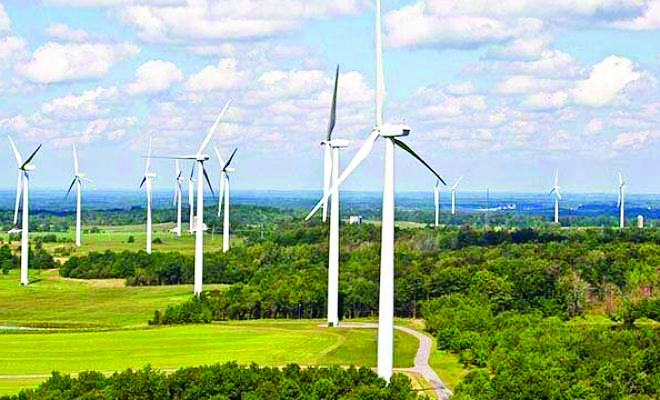India is gearing up for green transition through policy and budgetary support to reduce dependence on finite fossil fuels, to curb greenhouse gas emissions, and to mitigate climate change. The Viksit Bharat 2047 vision aims to transform India into a developed nation, which will drive a significant rise in energy demand across industries, infrastructure, and households. To meet this growing demand sustainably, India must focus on renewable energy expansion and green technologies. India is moving towards its Net Zero goal by allocating budgetary support to the green energy sector to accelerate sustainable development, while balancing it with its growth and developmental aspirations. The primary focus of the mitigation effort on the budgetary allocation in the Union Budget 2025-26 is on solar and nuclear sources.
Solar energy gets top priority
There has been 39% increase in net revenue expenditure in nominal terms in budget estimates for Ministry of New and Renewable Energy in 2025-26 as compared to 2024-25. For solar energy, there is 48% increase in budget allocation in 2025-26 as compared to 2024-25, in nominal terms, mainly allocated for revenue expenditure.
Under central sector schemes, major increase in budget allocation happened in PM Surya Ghar Muft Bijli Yojana, which increased from INR 6,250 crore in 2024-25 budget estimate to INR 20,000 crore in 2024-25. There is also increase in budget allocation on Kisan Urja Suraksha evam Utthaan Mahabhiyan (KUSUM) from INR 1496 crore in 2024-25 to INR 2600 crore in 2025-26. These two programs are gaining importance in promoting solar energy, since the allocation for both these programs were increased in revised estimates on 2024-25 as compared to budget estimates. While under PM Surya Ghar Muft Bijli Yojana the government is targeting to solarizing one crore households by providing free electricity upto 300 units every month, KUSUM program aims to increase the income of farmers, provide sources for irrigation, de-dieselization the agricultural sector, promoting setting up of standalone solar pumps and solarization of existing grid-connected agricultural pumps.
Under the Other Central Sector Expenditure head, there is 42% increase in budget allocation in nominal terms on National Institute of Solar Energy, from INR 20 crore in 2024-25 to INR 28.4 crore in 2025-26. Majority of the expenditure happened in revenue section, while capital expenditure for these renewable energy sources has shown some dip.
Budgetary push for nuclear energy
Significant importance is laid upon Nuclear Energy Mission for Viksit Bharat, which envisions the addition of 100 GW of nuclear energy capacity by 2047. This initiative is expected to be a major contributor to India’s low-carbon energy mix. Additionally, a dedicated Nuclear Energy R&D Mission of Small Modular Reactors (SMR) with a budget of INR 20,000 crore is announced to drive innovation. There is 12% increase in gross budgetary allocation on revenue expenditure to the Department of Atomic Energy from 2024-25 to 2025-26, and in net terms, it is 9% increase in budget allocation, after adjusting recoveries and receipts. However, budgetary allocation for capital expenditure has reduced by 14% in 2025-26 over the past year.
Low emphasis on other renewable energy sources
Under Other Central Sector Expenditure, there is 47% increase in budget allocation in nominal terms on National Institute of Bio Energy, from INR 9.5 crore in 2024-25 to INR 14 crore in 2025-26. But under Central Sector Schemes/Projects, wind energy sector faced deceased allocation from INR 800 crore in 2024-25 to INR 500 crore in 2025-26. Ideally for grid balancing with an increasingly higher share of renewable electricity, it is essential to encourage growth of alternative renewable sources like wind, pump storage electricity, etc. However, this year union budget has not been forthcoming in this direction.
Enhancing Energy Storage and Grid Infrastructure
The ‘Make in India’ initiative has been extended to include clean technology manufacturing. To improve domestic value addition and reduce reliance on imports, the government is promoting local production of solar PV cells, EV batteries, motors and controllers, electrolyzers, wind turbines, very high-voltage transmission equipment, and grid-scale batteries. These efforts will enhance India’s self-sufficiency in clean energy technology while creating employment opportunities in the sector.
A major challenge in transitioning to renewable energy is ensuring stable and reliable power supply, given the intermittent nature of solar and wind energy. There is also infrastructure needed for increasing acceptability of electric vehicles. To address this, India has prioritized investments in energy storage. There is also emphasis on enhancement of battery storage, through allocation on Production Linked Incentive (PLI) Scheme for National Programme on Advanced Chemistry Cell (ACC) Battery Storage, which is the new generation of advanced storage technology. This initiative is expected to drive significant growth in key battery-consuming sectors, including consumer electronics, electric vehicles, advanced power grids, and solar rooftops, and reduce dependence on imports. There is budget allocation of INR 155.76 crore on this scheme in 2025-26 union budget.
To encourage domestic manufacture of lithium-ion battery, which is required for both mobile phones and electric vehicles, budget 2025-26 also proposed to add 35 capital goods for EV battery manufacturing, and 28 capital goods for mobile phone battery manufacturing. The budget 2025-26 also proposed to fully exempt cobalt powder and waste, the scrap of lithium-ion battery, Lead, Zinc and 12 more critical minerals, to encourage domestic manufacturing, and thus enhancing employment.
Green Mobility Initiatives
There is significant emphasis on promoting electric mobility in the budget 2025-26. Under PM Electric Drive Revolution in Innovative Vehicle Enhancement (PM E-DRIVE) Scheme, which targets to comprehensive ecosystem for electric mobility, there is budget allocation of INR 4000 crore in 2025-26, and this allocation has more than doubled from the revised estimates of 2024-25. This scheme facilitates the adoption of e-trucks, e-buses, e-ambulances, and EV public charging stations. To reduce emissions in urban transportation, there is significant increase in allocation for PM e-Bus Sewa Scheme, for capital expenditure (INR 500 crore) in the budget 2025-26. Launched at 2023, this scheme targets at deploying over 38,000 electric buses across the country. Additionally, INR 12 crore is allocated to promote manufacturing of Electric Passenger Cars in India (SMEC), which aims to attract investments from global Electric Vehicle (EV) manufacturers and promote India as manufacturing destination for e-vehicles.
Summing Up
The government’s initiatives reflect their approach towards sustainability through emphasis on renewable energy generation, which is evident from significant increase in allocation in solar sector development, while areas like domestic manufacturing of storage, electric mobility and grid modernization are also covered. With the constraint in resources due to slowing of economic growth in recent years, allocation of budget funds is a challenge in India, where social sector is always a priority. But also, to support the goals of Viksit Bharat and Atmanirbhar Bharat, we need to mobilize resources for development of energy infrastructure, fostering domestic manufacturing, ensuring financial viability of clean energy projects, and incentivizing technological innovation in energy sector for a greener and resilient energy future.
* Chetana Chaudhuri, Fellow, National Council of Applied Economic Research (NCAER)) and Prof. Sanjib Pohit, Professor & Thematic Lead—CGE Modelling and Policy Analysis, NCAER.








